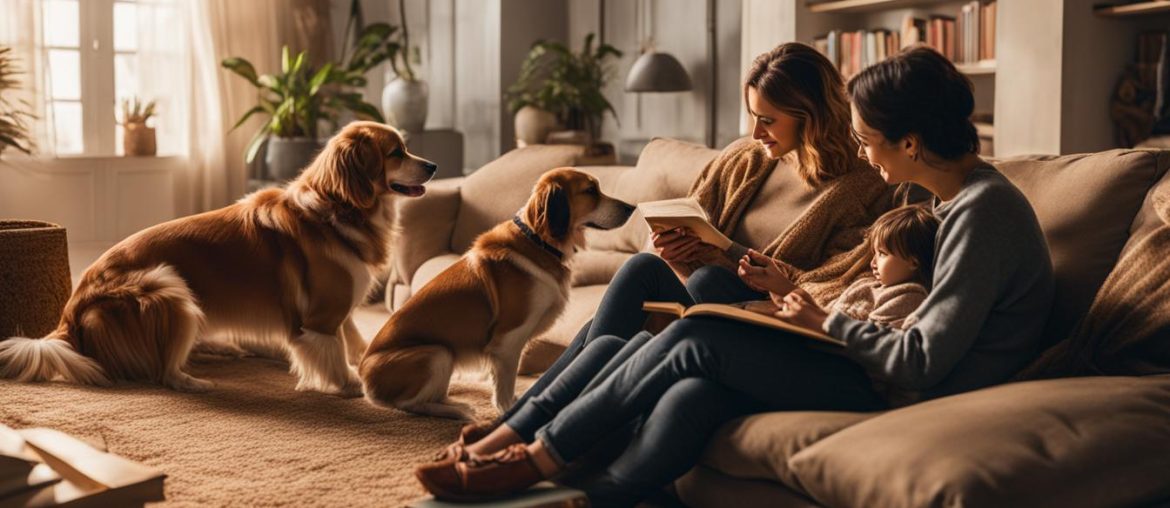Are you looking for a furry friend that matches your laid-back lifestyle? If so, you’ve come to the right place. In this article, I will explore the top 12 low-energy dog breeds, ideal companions for those seeking a less strenuous pet ownership experience. Whether you’re a busy professional or simply enjoy a calm and peaceful home environment, these lazy and calm dog breeds will bring joy and companionship without overwhelming energy levels.
Before we dive into the specific breeds, it’s important to consider a few things. I’ll discuss the importance of lifestyle evaluation to ensure the right fit for your routine. Each dog breed has unique needs and characteristics, so understanding your own lifestyle is crucial in making an informed decision.
Key Takeaways:
- Low energy dog breeds are perfect companions for those seeking a calm and peaceful home environment.
- Before getting a low-energy dog, conduct a lifestyle evaluation to ensure compatibility.
- Every dog has individual characteristics and energy levels, so thorough research is essential.
- Consider adopting a senior dog as they often have lower exercise requirements and established behaviors.
- When choosing a low-energy breed, factors such as age, training, diet, and responsibilities of dog ownership should be considered.
Lifestyle Evaluation: Finding the Right Fit for Your Routine
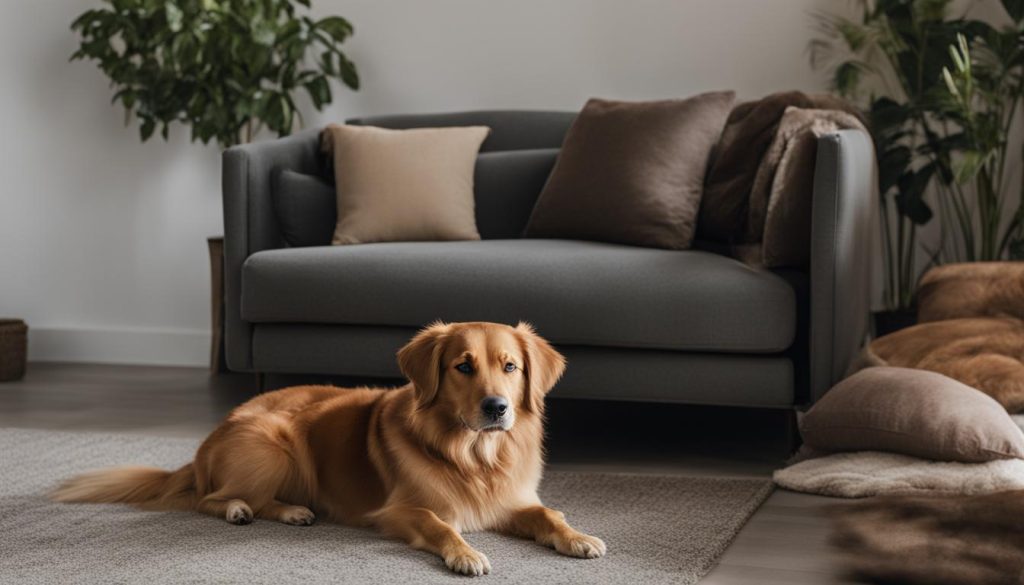
When considering bringing a dog into your life, it is essential to conduct a thorough lifestyle evaluation to ensure that the chosen breed aligns with your daily routine. Owning a dog comes with certain responsibilities and commitments, and understanding your lifestyle is crucial in making an informed decision about the type of dog that will be the right fit for you.
As a potential dog owner, it is important to recognize that dogs require love, care, and attention. Along with providing affection and companionship, there are other responsibilities to consider, such as grooming, training, and mental stimulation. Dogs need daily exercise and socialization, so it is essential to evaluate if your routine can accommodate these requirements.
Additionally, it is important to remember that not all low-energy dog breeds have the same behavior or energy level. While they may generally be calmer and less energetic than other breeds, individual temperaments can vary. Age, training, and diet can influence a dog’s energy levels, even within low-energy breeds. It is crucial to research and understand the specific traits, temperament, size, and coat type of the breed you are considering.
By conducting a lifestyle evaluation and understanding the responsibilities of dog ownership, you can find the perfect low-energy breed that fits seamlessly into your routine. Taking the time to ensure a good match will result in a harmonious and fulfilling relationship between you and your four-legged companion.
Table: Responsibilities of Dog Ownership
| Responsibility | Description |
|---|---|
| Affection and Companionship | Dogs thrive on love and attention, so providing affection and companionship is crucial for their emotional well-being. |
| Grooming | Regular grooming, such as brushing, bathing, and nail trimming, is necessary to keep your dog clean and healthy. |
| Training | Training your dog is essential for their behavior and obedience. Basic commands, house training, and socialization are crucial for a well-adjusted pet. |
| Mental Stimulation | Dogs need mental exercise to prevent boredom and destructive behaviors. Providing puzzle toys, training sessions, and interactive playtime is necessary to keep their minds active. |
| Daily Exercise | Every dog requires physical exercise to maintain a healthy weight and overall well-being. Daily walks, playtime, and activities are essential for their physical health. |
Individuality of Dogs: Uniqueness Beyond Breed Generalizations

When it comes to low-energy dog breeds, it’s important to remember that every dog is unique. While breed generalizations can provide some insight into energy levels, it’s essential to conduct thorough research on individual temperaments before bringing a new pet home. Factors such as age, training, and diet can significantly influence a dog’s energy level, even within low-energy breeds.
When considering a low-energy dog breed, it’s crucial to take into account various breed traits, temperament, size, and coat type. This will ensure that the dog’s needs align well with your lifestyle and preferences. For example, some low-energy breeds, like Greyhounds, may require frequent companionship to feel secure and content, while others, such as Basset Hounds, may have a more laid-back demeanor.
Factors Influencing Energy Levels
Several factors can influence a dog’s energy level, regardless of their breed. Here are a few key considerations to keep in mind:
- Age: Puppies may have bursts of energy followed by long periods of rest, while senior dogs often have lower exercise requirements.
- Training: Well-trained dogs tend to be more focused and have better impulse control, which can impact their energy levels.
- Diet: A balanced diet that meets a dog’s nutritional needs can contribute to their overall energy levels and well-being.
By understanding the individuality of dogs and the factors that influence their energy levels, potential dog owners can make informed decisions when choosing a low-energy breed that best suits their lifestyle.
| Breed | Temperament | Exercise Requirements | Compatibility with Low-Energy Lifestyles |
|---|---|---|---|
| Greyhound | Gentle, affectionate | Regular brisk walks | Ideal for apartment living |
| Basset Hound | Laid-back, friendly | Daily walks, sniffing activities | Requires a moderate exercise routine |
| Pug | Affectionate, loyal | Moderate exercise, avoiding overexertion | Adapts well to low-energy households |
Adopting a Senior Dog for a Low-Energy Companion
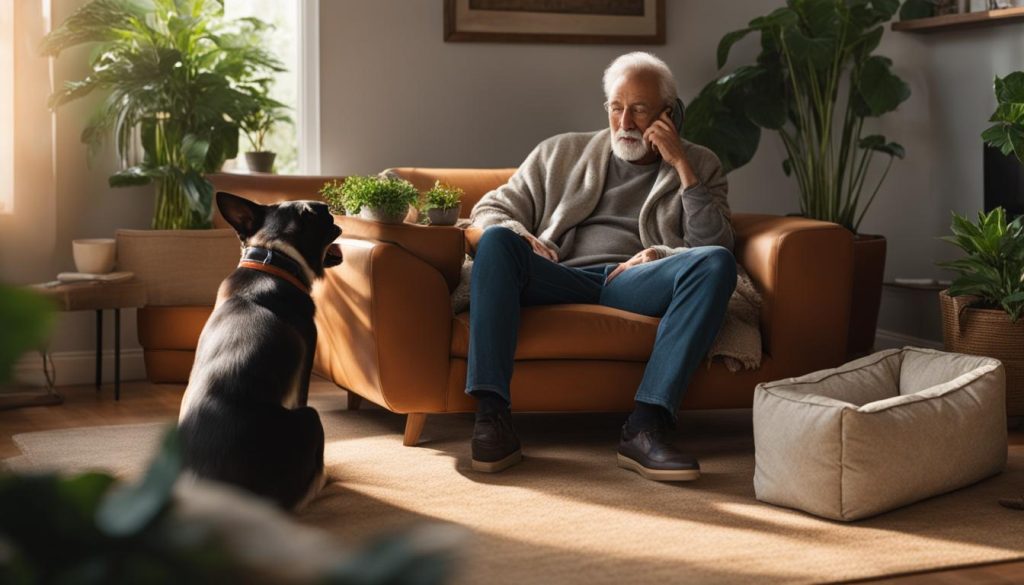
When it comes to finding a low-energy dog breed that is a perfect fit for your lifestyle, adopting a senior dog can be a wonderful choice. Senior dogs often have lower exercise requirements and established behaviors, making them easier to manage compared to puppies or younger dogs.
One of the key benefits of adopting a senior dog is the time commitment. Training and socializing a puppy can be time-consuming, but with a senior dog, you can skip the early stages and enjoy the companionship right away. Senior dogs have already developed their personalities and are usually more relaxed and calm, making them ideal for those seeking a low-energy companion.
Not only are senior dogs easier to care for, but they also deserve a loving home in their golden years. Many older dogs end up in shelters due to various reasons, including the loss of their previous owner or changes in family circumstances. By adopting a senior dog, you are providing them with a second chance at happiness and a comfortable retirement.
When adopting a senior dog, it’s important to keep in mind their specific needs. Regular vet check-ups, a balanced diet, and appropriate exercise are essential for their well-being. Additionally, providing them with a comfortable and cozy living environment will help them feel safe and secure. With the right care and love, your senior dog can become a cherished member of your family.
Table: Benefits of Adopting a Senior Dog
| Benefits | Description |
|---|---|
| Lower exercise requirements | Senior dogs are generally less active and require less physical activity compared to younger dogs. |
| Established behaviors | Senior dogs often have already gone through basic training and are well-behaved. |
| Immediate companionship | You can skip the early stages of training and enjoy the companionship right away. |
| Provide a loving home | Many senior dogs end up in shelters and deserve a comfortable and caring retirement. |
| Less time commitment | Training and socializing a senior dog requires less time compared to puppies or younger dogs. |
Adopting a senior dog can be a rewarding experience for both you and your new furry friend. Not only will you have a loving and loyal companion, but you will also provide a second chance at happiness for a deserving dog. Take the time to consider adopting a senior dog and enjoy the benefits of having a low-energy companion by your side.
Factors to Consider When Choosing a Low-Energy Dog Breed
When selecting a low-energy dog breed, there are several important factors to consider. It’s essential to understand that energy levels can vary within the same breed due to factors such as age, training, and diet. By taking these factors into account, as well as understanding the responsibilities of dog ownership, you can make an informed decision and find the perfect low-energy companion for your lifestyle.
Age is a significant factor when considering a low-energy dog breed. Puppies, while adorable, require a significant amount of time and energy for training, socialization, and exercise. On the other hand, senior dogs often have lower exercise requirements and established behaviors, making them easier to manage. Adopting a senior dog can be a rewarding experience, providing a loving home for a deserving companion while eliminating the time commitment required for training and socializing a puppy.
Training and diet also play a role in a dog’s energy level. Dogs that have received proper training and have been provided with a balanced diet are generally more well-behaved and have consistent energy levels. Please be aware that some low-energy dog breeds may still require mental stimulation and occasional exercise to prevent boredom and promote overall well-being.
| Factors | Considerations |
|---|---|
| Age | Puppies require more time and energy, while senior dogs have lower exercise requirements |
| Training | Well-trained dogs tend to have more consistent energy levels |
| Diet | A balanced diet contributes to overall well-being and energy levels |
When considering a low-energy dog breed, it’s crucial to understand the responsibilities of dog ownership. Dogs require regular grooming, including bathing, brushing, and nail trimming. Additionally, they need mental stimulation through interactive toys and games, as well as basic obedience training. Providing affection, companionship, and ensuring their emotional well-being are also essential aspects of responsible dog ownership.
By carefully considering factors such as energy level variations, age, training, diet, and the responsibilities of dog ownership, you can choose a low-energy dog breed that aligns with your lifestyle and provides you with a loving and loyal companion.
Top 12 Famous Low Energy Dog Breeds

When it comes to finding a low-energy dog breed that fits perfectly into a quiet and relaxed lifestyle, there are several options to consider. Here, I have compiled a list of the top 12 famous low-energy dog breeds that are known for their calm and laid-back nature. Whether you live in an apartment or have limited space, these breeds are ideal companions for those seeking a more relaxed and balanced pet ownership experience.
Below is a table summarizing the key traits, exercise requirements, and compatibility of each breed:
| Breed | Traits | Exercise Requirements | Compatibility |
|---|---|---|---|
| Greyhound | Elegant and gentle, known for their sprinting abilities | Moderate exercise, frequent rest periods | Good with children, caution with cats |
| Basset Hound | Laid-back and affectionate, excellent sense of smell | Daily walks, gentle exercise | Gets along well with other pets, good with children |
| Pug | Adorable and sociable, known for their flat faces | Moderate exercise, avoid overexertion | Good with families and other pets |
As you can see, each breed has its own unique characteristics and activity levels. It’s important to consider factors such as exercise requirements, compatibility with other pets, and the breed’s temperament before making a decision. Remember, every dog is an individual, so it’s always a good idea to spend time with the specific dog you are considering to ensure a good match.
By choosing a low-energy dog breed that aligns with your lifestyle and preferences, you can enjoy the companionship of a loving and easy-going pet without the need for excessive exercise or stimulation. These breeds bring joy and contentment to quiet homes, making them ideal for individuals and families who prefer a more relaxed pet ownership experience.
Greyhound: The Couch-Loving Sprinter
The Greyhound is a prime example of a low-energy dog breed that thrives in a relaxed environment. Despite their reputation as speedy sprinters, Greyhounds are surprisingly calm and make excellent couch potatoes. With their elegant stature and gentle demeanor, they are the perfect addition to any quiet home.
While Greyhounds are known for their exceptional athleticism, it’s important to note that they also have a remarkable ability to relax and enjoy downtime. These dogs have a low energy level, preferring to spend the majority of their days lounging on comfy couches or snuggled up with their owners. Their love for relaxation makes them an ideal choice for apartment living or for individuals who prefer a more laid-back lifestyle.
When it comes to companionship, Greyhounds thrive on being close to their human family members. They are extremely affectionate and form strong bonds with their owners, seeking constant reassurance and love. However, due to their history as hunting dogs, it’s essential to exercise caution when introducing them to small animals, as their prey drive may be triggered.
Greyhound Care Tips
- Give plenty of affection and attention to satisfy their social needs
- Provide a comfortable, cozy bed for their lounging pleasure
- Engage in regular but moderate exercise, such as short walks or playtime in a secure area
- Ensure a balanced diet and maintain a healthy weight to support their well-being
- Consider their sensitivity to extreme temperatures and protect them accordingly
The Greyhound is a wonderful choice for those seeking a low-energy dog breed that combines elegance with a couch-loving personality. These gentle giants provide unwavering loyalty and make excellent companions for individuals or families looking for a relaxed and loving pet.
Basset Hound: The Laid-Back Sniffer
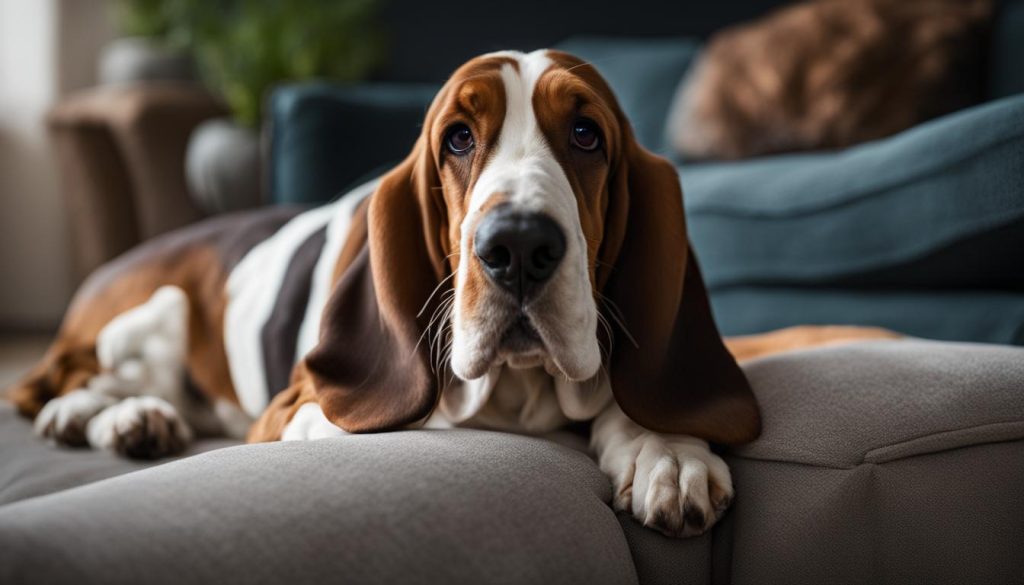
The Basset Hound is a popular low-energy dog breed known for its laid-back nature and exceptional scenting abilities. With their long, droopy ears and distinctive body shape, Basset Hounds are instantly recognizable and have captured the hearts of many dog lovers.
While Basset Hounds may not be the most active dogs, they still require regular exercise to stay healthy and happy. Gentle walks and sniffing sessions are ideal for this breed, as they allow Basset Hounds to explore the world around them while keeping their exercise levels manageable.
“Basset Hounds have an incredible sense of smell and love to follow scents. Engaging their nose during exercise can provide mental stimulation and satisfy their natural instincts.” – BassetHoundExpert.com
Please be aware that due to their unique skeletal structure and elongated backs, Basset Hounds should avoid excessive jumping or strenuous exercise that could put strain on their joints. This breed is prone to certain health issues, such as ear infections and obesity, so regular check-ups with a veterinarian are essential to ensure their well-being.
| Key Characteristics | Exercise Needs | Grooming Requirements | Training Difficulty |
|---|---|---|---|
| Laid-back and friendly | Low to moderate | Regular brushing to prevent matting | Moderate |
With their affectionate and easy-going nature, Basset Hounds make wonderful companions for families and individuals looking for a low-energy pet. They are generally good with children and other pets, although early socialization is still important to ensure their well-rounded development.
Overall, the Basset Hound’s gentle exercise needs, calm temperament, and unique appearance make them a beloved member of many households seeking a low-energy dog breed.
Pug: The Adorable Flat-Faced Companion
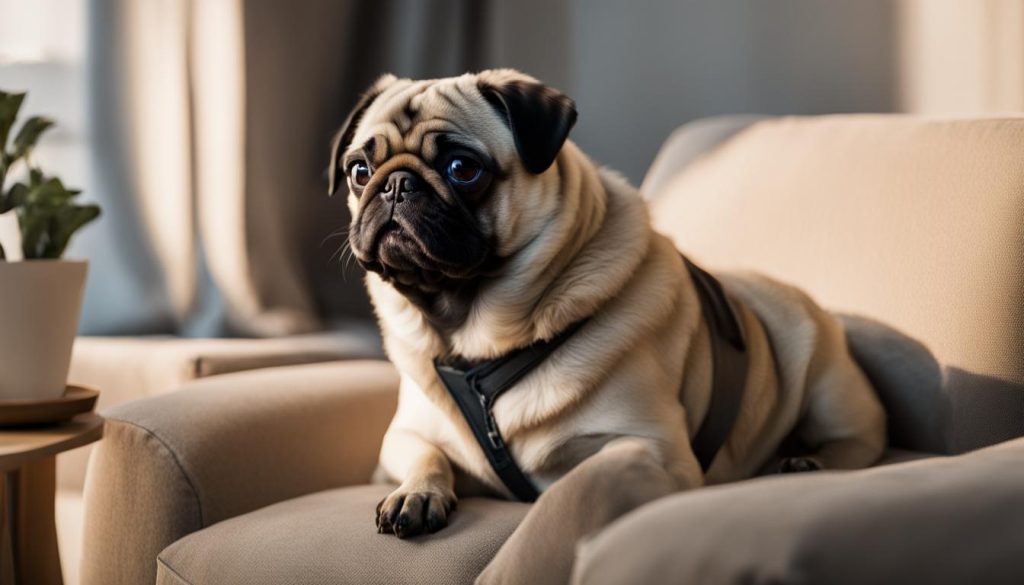
The Pug is a popular low-energy dog breed known for its adorable flat face and affectionate nature. These small-sized dogs make excellent companions for individuals or families seeking a calm and laid-back pet. With their charming personality and unique appearance, Pugs have captured the hearts of dog lovers worldwide.
Despite their small stature, Pugs have a moderate energy level, making them well-suited for a low-energy lifestyle. They enjoy short walks and play sessions, but they are not overly demanding in terms of exercise. This makes them a great choice for individuals who may not have the time or physical capability for long walks or rigorous activities.
It is important to note that Pugs are a brachycephalic breed, meaning they have a short muzzle and flat face. While this characteristic gives them their distinctive look, it can also lead to certain health issues. Pugs are prone to respiratory problems and may experience difficulty breathing, especially in hot or humid conditions. It is crucial to provide them with proper care, including regular vet check-ups and monitoring their environment to ensure they stay comfortable and healthy.
Key Characteristics of Pugs:
- Size: Small
- Temperament: Affectionate, friendly, and sociable
- Exercise needs: Moderate
- Care requirements: Regular grooming to maintain their coat, regular vet check-ups for health monitoring
- Training: Pugs are intelligent but can be stubborn at times, so positive reinforcement training methods work best
“Pugs are known for their loyalty and dedication to their owners. They thrive on human companionship and will eagerly snuggle up beside you on the couch. Their adorable wrinkled face and expressive eyes are hard to resist, making them a joy to have as part of the family.” – Professional Dog Trainer
Wrapping Up
In conclusion, low-energy dog breeds are the perfect companions for quiet homes. Their calm and gentle nature offers a more relaxed and balanced lifestyle for their owners. By considering factors such as lifestyle evaluation, the individuality of dogs, and the benefits of adopting a senior dog, potential owners can find the ideal low-energy breed that fits their specific needs.
It is important to remember that low-energy dog breeds still require proper care and attention. Providing them with affection, grooming, training, and mental stimulation is crucial for their well-being and happiness. While they may not have high exercise requirements, it is essential to meet their needs and ensure they lead a healthy and fulfilling life.
By choosing a low-energy dog breed, you can enjoy the companionship and love of a furry friend without overwhelming activity levels. These breeds make excellent pets for individuals or families seeking a quieter and more peaceful pet ownership experience. So, if you’re looking for a calm and low-energy companion, consider adopting one of these wonderful breeds and create a harmonious bond that will bring joy to your life.
FAQ
What should I consider before getting a low-energy dog breed?
Before getting a low-energy dog breed, it’s important to conduct a lifestyle evaluation to ensure it aligns with your routine. You should also be prepared for the responsibilities of dog ownership, such as providing affection, grooming, training, and mental stimulation.
Are all dogs of a specific low-energy breed guaranteed to have the same energy level?
No, every dog possesses its own unique individuality, even within specific low-energy breeds. Factors like age, training, and diet can influence a dog’s energy level. It’s essential to research individual temperaments before bringing a new pet home.
What are the benefits of adopting a senior dog as a low-energy companion?
Senior dogs often have lower exercise requirements and established behaviors, making them easier to manage. By adopting a senior dog, you can provide a loving home and eliminate the time commitment required for training and socializing puppies.
How important is it to evaluate factors when choosing a low-energy dog breed?
It is crucial to consider factors such as breed traits, temperament, size, and coat type when choosing a low-energy dog breed. Energy levels can vary within the same breed, and understanding the responsibilities of dog ownership is essential.
Which are some of the famous low-energy dog breeds?
Some of the famous low-energy dog breeds include Greyhounds, Basset Hounds, and Pugs. Each breed has its specific traits, exercise requirements, and compatibility with low-energy lifestyles. Health considerations and care needs should also be taken into account.
What are the characteristics of Greyhounds as a low-energy dog breed?
Greyhounds are known for their couch potato nature and preference for frequent companionship. However, caution is advised when it comes to their compatibility with cats. They are well-suited for apartment living due to their low-energy temperament and love for lengthy rest periods.
What are the characteristics of Basset Hounds as a low-energy dog breed?
Basset Hounds have a laid-back demeanor and are considered low-energy dogs. They require daily walks but should be prevented from developing ear and joint problems due to their unique skeletal structure. They love sniffing and prefer a more gentle exercise routine.
What are the characteristics of Pugs as a low-energy dog breed?
Pugs have lower energy levels and are known for their adorable flat faces. However, they can experience health issues associated with brachycephalic breeds. Pugs are dedicated and affectionate, preferring to be close to their owners. They require moderate exercise and should avoid overexertion.


